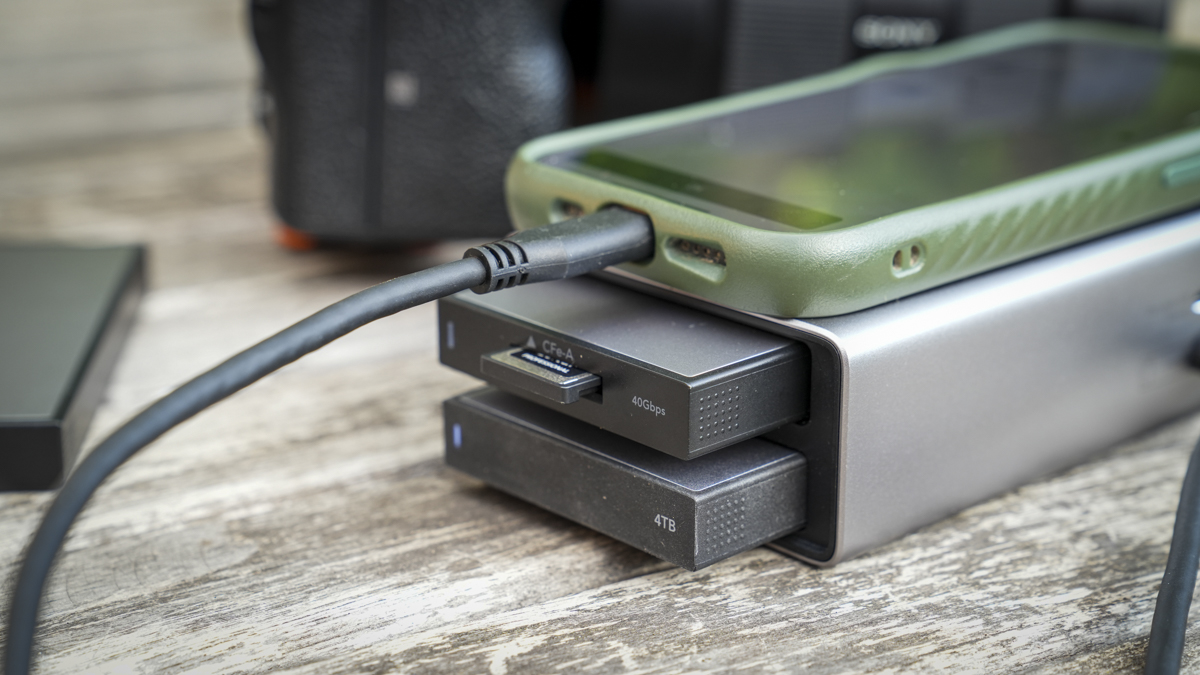TechRadar Verdict
Few devices have integrated into my daily photography and video work as smoothly as the Workflow Go. It enables me to offload memory cards directly to the SSD module, then view and share files without any need for a computer, just using the phone app. It might look like a simple oversized card reader, but in reality, it's so much more. It utilises an app to manage files so you can leave your laptop at home, and with the same modules as the Workflow, it complements the studio version, adapting to what you need as a professional photographer or videographer.
Pros
- +
Flexible modular design
- +
Intuitive companion app
- +
Swappable battery packs
Cons
- -
Modules sold separately
- -
No weather sealing
- -
No tablet version of the app
Why you can trust TechRadar
Lexar Workflow Go: 30-second review
The Workflow Go is pretty much unique in the market, and is essentially a portable docking station with an interchangeable battery and a series of modules to give you access to a variety of memory card readers and SSDs that you can manage through an app.
The main body of the unit consists of two parts: the docking station and the interchangeable battery that slots into the base. In addition to the main body of the unit, there are also a series of modules. These include SD card readers for CFexpress Type A and B, microSD and SD cards, pretty much covering all bases.
Alongside the memory card readers, there are two SSD storage options ranging from 2 to 4 TB, the capacity that I've reviewed. One key points of these modules is that they're the same as those used with the Lexar Workflow, the studio-based option that I looked at earlier in the year. These modules can also be used in isolation with a standard USB-C port at the back. So even if you don't have the Workflow Go with you, you can still plug it directly into a computer, tablet or compatible smartphone.
Getting started with the Workflow Go is easy with two caddy slots that will take in two modules, say an SD card reader and a 4 TB SSD. Once the modules are inserted and the device is switched on, you can then connect using the companion app, which is available for both iOS and Android devices.
Through the app, you can quickly choose to offload your files from the SD card to the SSD, making sure that you have a good backup. You can also organise them and share them with others. As I often work as part of a team with a designer, what I really liked here was the fact that I could purchase a secondary 2 TB SSD module so that my colleague could walk away from the shoot with the full selection of images from the day. It just meant that when I got home, I didn't have to upload and transfer them across, and on the next shoot, that 2TB drive could be returned for the next set of images.
One issue is that the 2TB SSD module itself is almost double the price of most other 2 TB SSDs, but using it in a professional environment, the pure convenience far outweighs the initial outlay, and this is, after all, a high-quality professional product that should last for years. There is however a cheaper option as you can plug in an external SSD such as the Lexar Armour SL500, and this works just as well, and this would set you back around $150 / £150.
From the outset, I was impressed with the transfer speed of files from the memory cards or all types to the SSD module. Files from a CFexpress Type-B card used to record 4K video footage from the Canon EOS R5C were copied to the 4 TB SSD in just over a minute and a half. The fact that it's a direct hardware connection between the SSD and the card reader meant it was far faster than some other mobile storage options that I have used in the past. Thankfully, the battery also had plenty of capacity to last out the day, and I liked the fact that towards the end of the shoot, when the battery level was dipping, I could plug it into a portable power bank to give it a boost.
Sign up to the TechRadar Pro newsletter to get all the top news, opinion, features and guidance your business needs to succeed!
I've now been using the Workflow for about three months on a variety of different photo shoots and video productions. In every single case, the fact that I have on-location backup and file management has been incredibly useful, and when I get back to the studio, I can then extract those modules from the front of the Workflow Go and plug them directly into the main Workflow. This alone makes a huge difference to the speed of my Workflow.
Essentially, this small device, whilst expensive, especially when all totalled up, makes a huge difference to the ease of my day-to-day work and is now something that I would not be without. And what's more, with those that I work with, it's become so popular that they too have started to invest in the modules, if not the full system, for ease of use and speed when working professionally.
Lexar Workflow Go: Price and availability
- How much does it cost? £94 / $94
- When is it out? Now
- Where can you get it? Widely available
Lexar Workflow Go dock and battery combo is priced around $94, with the modules and SSDs being sold separately, anywhere from $59 for one of the SD card readers, $299 for a 2 TB SSD, $479 for a 4 TB SSD.
This puts the pricing above most enthusiast photographers but should sit within the budget of most professional photographers, especially considering the time that it will save you out in the field.
The system that I'm presently using out in the field consists of a Lexar Workflow portable SSD at 4 TB costing $479, Lexar Workflow reader CFexpress 4.0 Type B USB4 at $63.20, Lexar Workflow reader SD/microSD UHS-II USB 3.2 Gen 2 at $31.20, and Lexar Workflow reader CFexpress 4.0 Type A USB4 at $63.20, and Lexar Workflow Go portable two-bay dock with battery coming in at $94.
That all totals up to $730.60, which is quite substantial for the full workable system, just reinforcing that this is for professionals rather than enthusiasts.
- Value: 4 / 5
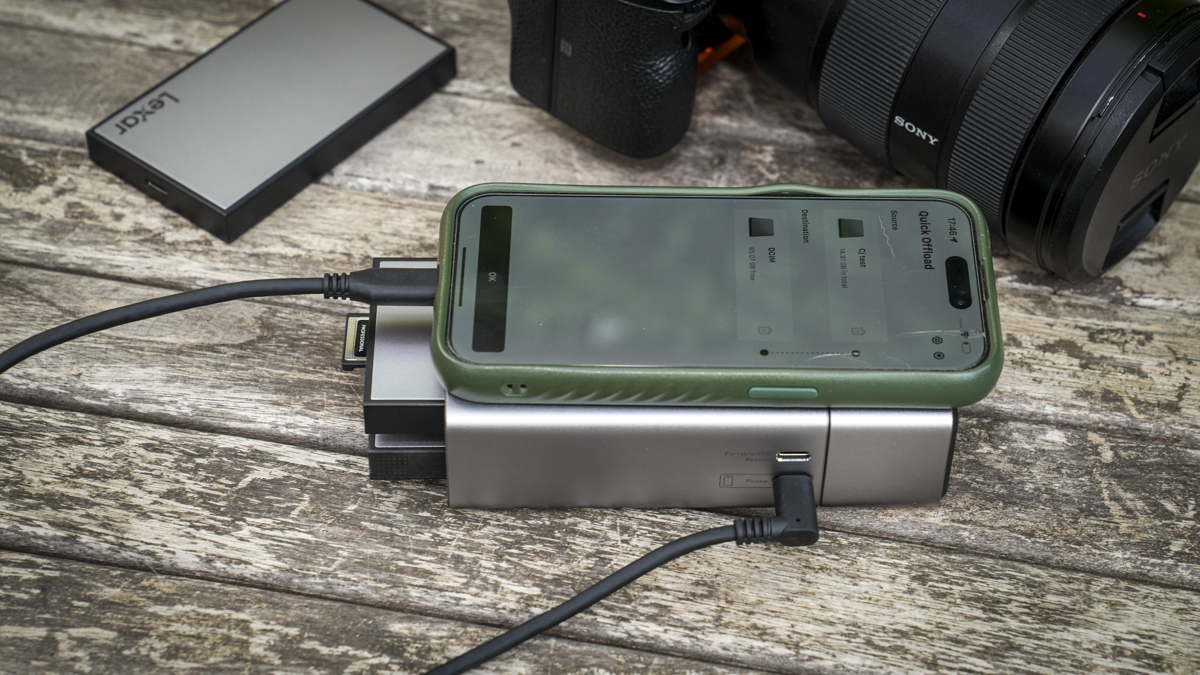
Lexar Workflow Go: Specs
Storage: Supports up to 4 TB via Lexar SSD module
Left Ports: USB-C power in/out
Right Ports: Modular SSD/Card Reader Bays
Connectivity: USB-C, Wi-Fi, and Direct USB-C mobile connection
Size: 136 × 77 × 38 mm (dock); 77 × 38 × 36.8 mm (battery)
OS Installed: Lexar Workflow mobile app (iOS/Android)
Accessories: Removable battery, card reader modules, SSD modules (sold separately)
Lexar Workflow Go: Design
Taking the Workflow Go out of the box, and the first thing that strikes you is its premium feel. The unit is finished with a matte surface with black plastic and metal accents, which really complements the main studio Workflow and, of course, any MacBook product.
The design is also exceptionally sleek and simple, with the battery unit and the main carry system clicking together. Then your selected modules simply slot into the front before you put a cable from the device into your laptop or tablet, or connect using the app through your mobile phone or tablet to manage and organise the files.
One of the things that instantly stands out is that the Workflow Go, while very neat, is substantially larger than most compact SSD and card readers combined. But then you're getting the convenience of the all-in-one approach and that management application. This enables you to not only offload the files but also manage them. The main dock itself weighs in at 318 g, with the battery adding another 156 g to the overall weight.
When it comes to the dimensions, the dock measures 136 x 77 x 38 mm, with the battery slotting onto the back measuring at 77 x 38 x 36.8 mm. Each of the modules is the same size, 77 x 38 x 36.8 mm, and each of these slots perfectly fits into one of the two caddy slots on the front of the dock.
One of the things that I really like about the design is that each module, because they're exactly the same shape and size, features a USB-C port on the back. This interfaces with a USB connector on the inside of the dock, and once in position, it's just push-fit, but it holds nicely and securely. Then, when you want to disconnect a module or swap it out, all you need to do is pull, and it will come directly out. It's all very precision-built, so it feels good and secure.
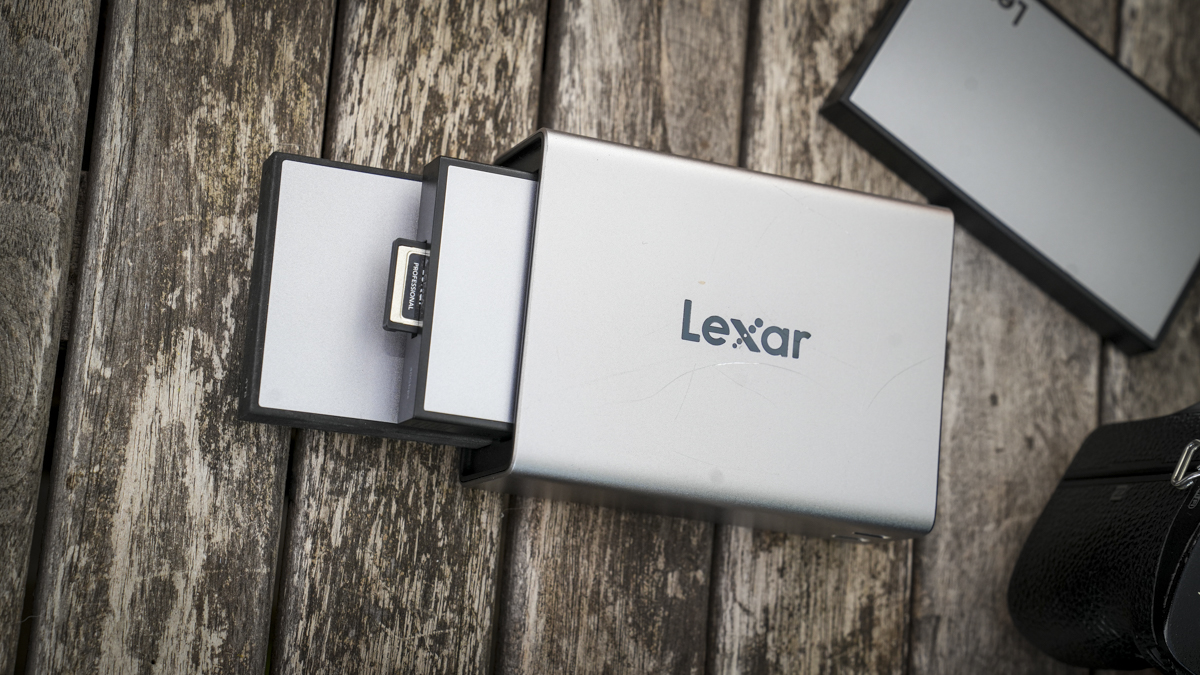
One of the things that I did notice is that, unlike some of the other docking stations that I've seen in the past, most notably the GNARBOX 2.0, this particular Workflow system isn't water or dust-proof. So you do need to be a little bit careful when you're working out in the field. And whilst in the summer this device has been out and about and used extensively, as we come into autumn and winter and we get more rainy days, I would've preferred something with just a little bit more environmental protection.
Once everything is connected and switched on, you can then connect to the mobile phone app, which again is quick and easy, with the Bluetooth connection making the contact between your phone and the device nice and quick.
What I did note was that, unlike many other devices of this type, the connection was good and robust. There are also LED battery indicators that just give you an idea of how long you have on the charge, and if it does look like you're getting low, then you can swap out for another battery pack, a feature I really like, or you can actually use PD power directly into the device to give it either a top-up charge or that little extra juice that it needs if you're using it all day long.
Essentially, whilst this device is extremely complex in the functions and features that it can do, outwardly the design has made it nice and simple and easy to use, making it ideal for a busy set or location shoot where you just want things to be quick and easy.
- Design: 4.5 / 5
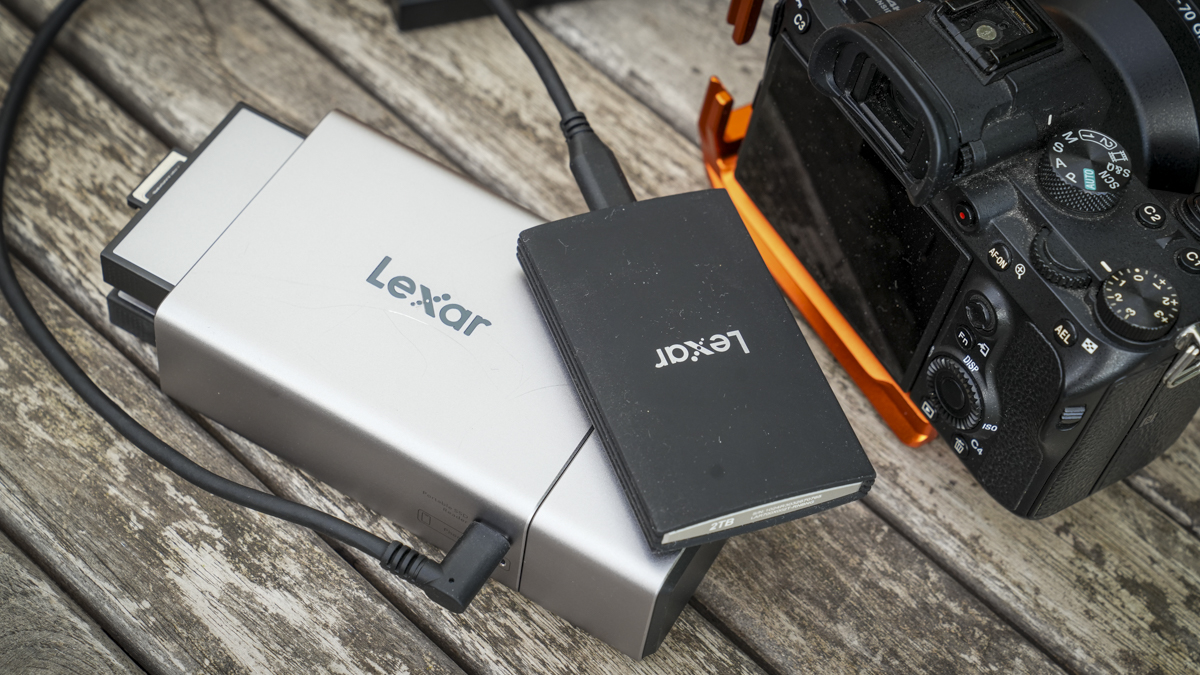
Lexar Workflow Go: Features
Lexar Workflow is a modular system and features a modular bay that supports the Lexar Workflow card reader and SSD modules. When it comes to storage, those SSD modules come in either a 2 or 4 TB version.
During this test, I utilised the 4 TB version for most of the review and then doubled with a 2 TB version which one of my colleagues purchased in order to quickly offload image files so that they could take them back to their studio and get processing done without needing to wait for his drive home and upload to my server so that they could then download.
When it comes to the memory card modules, there's a huge variety, including CFexpress Type A, CFexpress Type B, microSD and SD, giving you plenty of options.
Unlike most card readers, the Lexar Workflow Go is designed to be used out in the field without the need for a laptop or any device other than the smartphone with the Lexar app installed. This enables you to manage the files between the Workflow modules. On the base of the dock, you can attach the battery module, and this will give up to 6 hours of use and will also support reverse charging, so if your camera battery is lacking a bit of power and accepts USB charging, then you can simply plug the battery in, and it will give your camera battery a top-up charge.
Likewise, for mobile phones, tablets, lighting or anything else that you need to give a power boost. On the flipside of that, if the Lexar Workflow is getting a bit low on battery after a couple of days, then you can always plug in a portable power bank and utilise PD power to give the system a bit of a boost.
While at first glance the unit might just look like a glorified card reader, which, with a direct connection to your laptop, it can be, it is in fact far more. It's a full off-site media management system, and through the Lexar app, you can select your memory card, slot it into one of the readers, and then transfer all of that content over to one of the SSDs, essentially offloading your memory cards on-site onto a secure drive.
What's more, because of the design of the Lexar Workflow, you can also plug in external SSDs to do exactly the same, and the full system has been really carefully thought through to enable an easy-to-use file backup system. It's easy to manage.
One of the major advances and features of the system is that you can view the files from the day's shoot quickly and easily through your mobile device or tablet. Then, if there are images you need to send off quickly, you can select them, take them into Lightroom or the application you use to enhance, and get those sent off to your client within a few minutes, essentially keeping a nice, tight workflow for your files.
For one job, through the test, I had to send images off to a local paper. I was able to do this within five minutes of leaving the job, sitting in reception after the shoot, quickly offloading the images that I needed to the internal SSD, adjusting on my iPad in Lightroom and sending those off to the picture desk all within about five minutes.
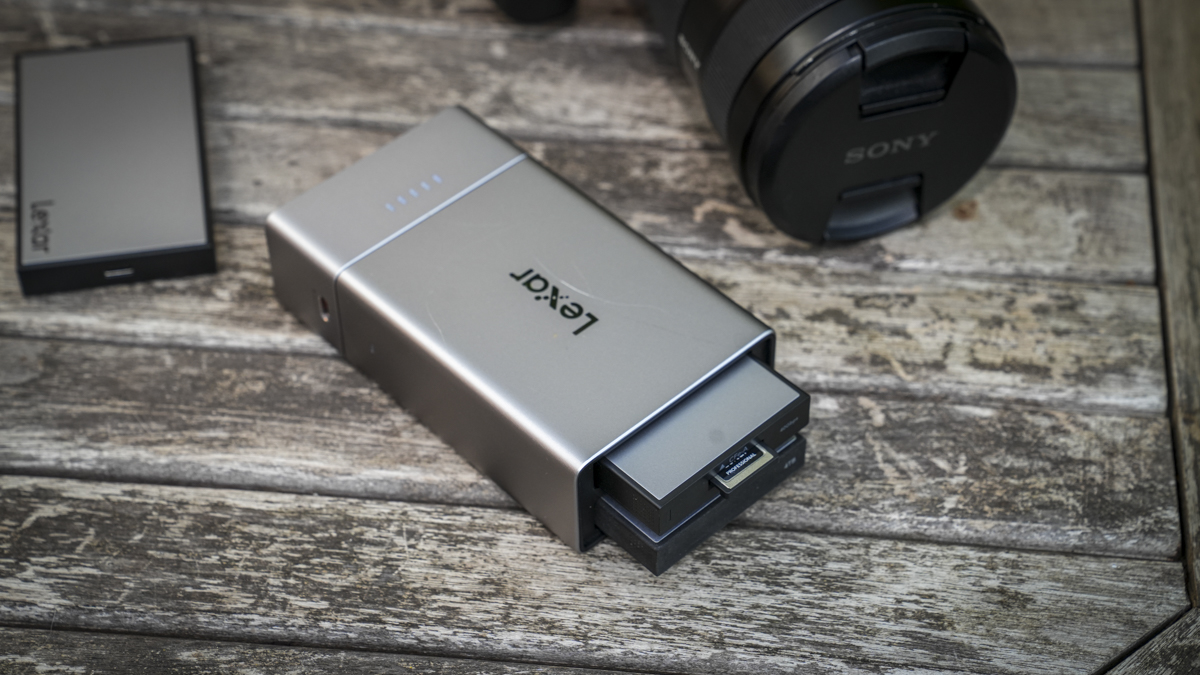
- Features: 5 / 5
Lexar Workflow Go: Performance
After giving the Workflow Go a full charge and selecting a set of modules that perfectly complemented the Sony A7 IV and GoPro Hero 13 that I was utilising on the job, it was time to head out the door.
Those modules included a 4 TB SSD, a microSD with SD, and a CFexpress Type A module, so three modules in total, and the Workflow Go dock with battery. The full size of the unit and modules is slightly larger than a portable SSD and card reader, but as I don't have a card reader with all of the different memory card type slots in, and that would have involved more cables and bits of equipment, having this one unit with two of the modules slotted in ready to go and the other one in a side pocket for when it was needed felt very neat and tidy.
Before I went out to the job, I also just wanted to make sure that everything was working seamlessly, so I downloaded the Lexar Workflow app onto my Apple iPhone 15 Pro and gave it all a quick test, finding that the connection was made quickly and that initial transfers between the SD card and the SSD were exceptionally fast, far faster than I anticipated.
On the first shoot, I had a CFexpress Type A card from the Sony Alpha 7 IV with around 40 GB of image data. I wanted to transfer that over to the SSD, utilising the app, and the interface was clear and easy to follow, essentially just highlighting that I wanted to offload the images onto the SSD and choosing the folder.
It only takes one or two tries of using the app before it becomes second nature. What was a little surprising was watching the percentage of the download spin around at such a fast speed. Essentially, that 40 GB of data took a little under 80 seconds to fully transfer. This is pretty much in line with what it does when I use a standard card reader to transfer those files over to my laptop, if not a bit faster.
Once the files were in place on the SSD, I could then navigate through the image gallery and check out all the files. If there was a file I needed to send off or look at more closely in Lightroom, I could open it up, adjust it, and send it off. It was nicely integrated and easy to use.
The other thing that was very notable was that I could use the companion app through Wi-Fi, or for an ultra-fast connection, plug into the USB-C port, which really helped boost those speeds.
I will admit that throughout the day, I was worried about the battery life. Although it states six hours, I was putting this device through its paces, so at just over five hours I plugged in an external power bank to give it a boost and a bit of charge. Through the day one of my colleagues was so impressed that on a later shoot, they had actually gone out and bought a 2 TB Workflow Go module so that they could quickly offload files from my camera, ready for laying out some of the books we were working on.
If you don't want to pay that additional amount for extra SSD modules, as they are exceptionally expensive, you can simply link in a standard portable SSD such as the Lexar SL500, which is a superb portable option.
Through the test, using the file management features of the Lexar Workflow app really highlighted this device as something very different from many of the workflow devices I've come across in the past. First and foremost, it was intuitive and easy to use, and the file integrity checks worked well. If there was an error, it would highlight it, and you could correct it easily.
I have to say that the overall use of the Workflow Go really does integrate with a professional photography and video workflow. There is a point that this is quite a bulky device compared with standard portable SSDs, even those from Lexar themselves, and card readers these days are also relatively small and compact.
By comparison, this is far larger. But in reality, this highlights that it is a professional piece of kit where that size and weight aren't going to be much of an issue. This is really designed for professionals working out in the field and often with teams who need to quickly offload images and video so that they can go onto the next stage of production as quickly and efficiently as possible.
Through my time with the Workflow Go, I can absolutely confirm that this device has made a huge difference to my day-to-day work, so much so that one of my colleagues has gone out and bought their own modules to utilise when we're working on projects together.
What I really liked was the fact that you can take the Workflow Go with you and get all those features and functionality, which is especially good at the end of the shoot when you're all sat down catching up and having some food and passing around the iPhone so you can just check through all the footage and images from the day, although I do wish there was an iPad optimised version.
I also liked the fact that those modules could be taken away and used in isolation, so if you do want to travel particularly light, then you can take the SSD or memory card modules with you and simply connect directly to your laptop with that USB-C connector.
- Performance: 5 / 5
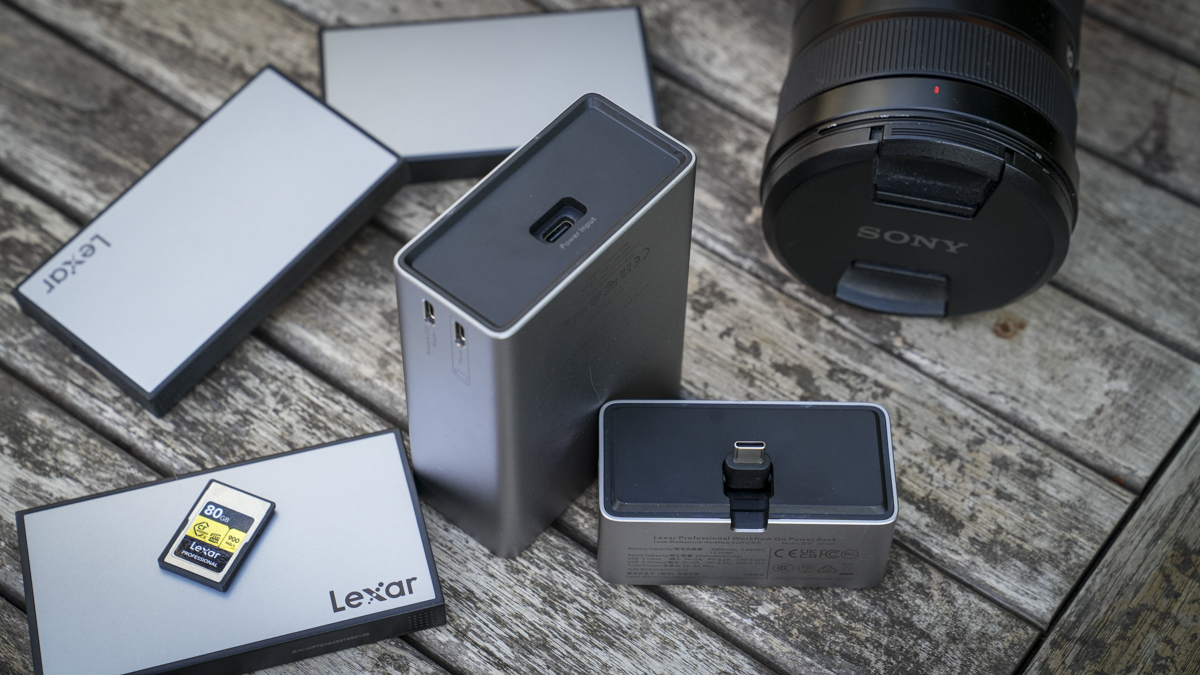
Lexar Workflow Go: Final verdict
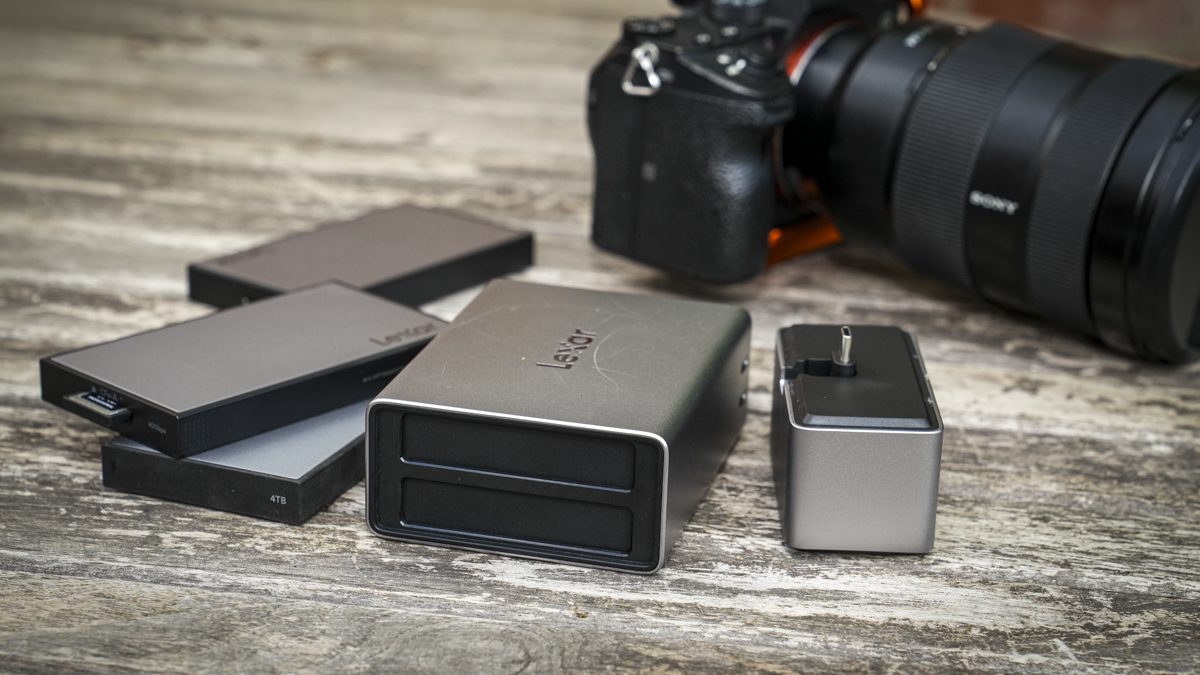
The Workflow Go is a huge investment, and if you're an enthusiastic photographer or videographer, then the overall outlay is going to be high. However, if you're a professional photographer, then having a device like this with its highly functional modular approach makes it ideal for field-based file management. It also enables others within your team to make use of their own modules and portable SSDs to offload files quickly, helping to speed up Workflow across the board, as you don't need to upload and then download files at the end of the day to some cloud-based solution.
I like the way that you can actually use this without a laptop and everything works just through your mobile phone or tablet, and then there's the fact that each of the modules can be utilised in isolation.
But for me, what's really become apparent is that whilst I'm out and about, I can use the Workflow Go just to check on the quality of the images I'm shooting, show those to clients and quickly transfer them across to colleagues without any issues. Then, when I get back to the studio, I can simply plug the modules directly into the full-sized Workflow with my studio-based machine for the full edits. It's just a really smooth transition from working out in the field to being back in the studio.
The Workflow Go, along with all the modules, is not a cheap solution, and if you're an enthusiast, while it would be great to have this type of functionality, it does come at a cost. However, for professionals, the cost is balanced with the speed that these modules and units will boost your production workflow and should, in time, pay for itself, making this an excellent investment for any professional videographer or photographer.
Should I buy a Lexar Workflow Go?
Value | For professionals, this is a great value product. Whilst expensive, it will help enhance your workflow | 4 |
Design | Premium quality design with a modular approach, just a shame that it's not dust or waterproof | 4.5 |
Features | Comprehensive and at the heart of the feature set, making this far more capable than most other devices on the market | 5 |
Performance | Working over Wi-Fi or directly through USB-C, the speed and ease of use are impressive | 5 |
Overalls | If you are a professional videographer or photographer looking for a workflow management system out in the field, this is it | 5 |
Buy it if...
You're a professional photographer or videographer
<p>The fact that you can select your modules and offload and view images and video out in the field without the need for a laptop makes this an exceptionally handy piece of kit.<p><strong>You work in a team<p>One of the surprise advantages of the system that I found was that my colleagues were able to offload my image and video files onto their own SSDs, so they didn't have to wait for me to upload them.Don't buy it if...
You're a hobbyist or enthusiast.
<p>While the initial outlay for the dock isn't huge and the module card readers are relatively inexpensive, once you start to add in the SSDs, the cost quickly escalates.<p><strong>You need a weatherproof solution.<p>While the Workflow is strong, it isn't designed to be used in more extreme environments with no weather or dust proofingto protect the modules or the dock itself.For more options, we've reviewed the best laptop docking stations around.
You must confirm your public display name before commenting
Please logout and then login again, you will then be prompted to enter your display name.
